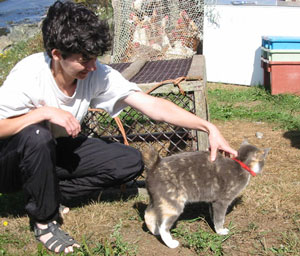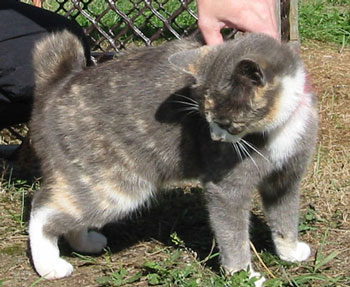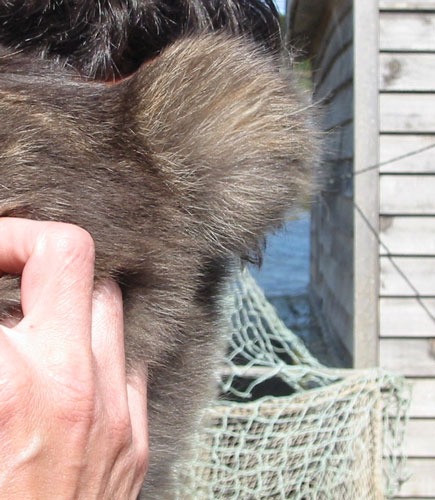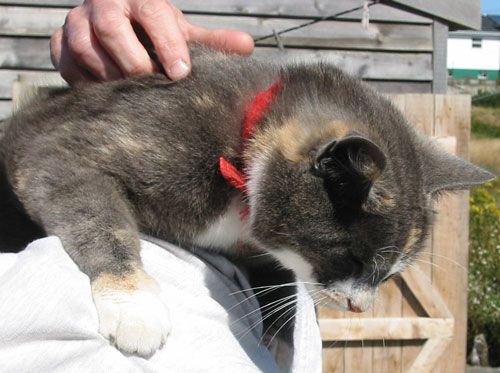
by
Amanda Bright
Several years ago my parents bought a new summer home on an island at the south end of Cape Breton, Nova Scotia. Chatting with my mother (a retired cat breeder), she mentioned that the cats on the island were unusual. Many had no tails and as we chatted we realized that many tailless cats have something in common: island habitats. Japan: Japanese Bobtails. Isle of Man: Manx and now Cymrics. Kuril Islands: Kurilian Bobtail and now one of the Cape Breton islands: the Cape Breton Bob. (In fact, I have also found references to bob-tailed cats in New York state as early as 1921.) My mother told me the cats ran wild on the island and while I have often wondered about the cats and their ancestry, I didn't ever visit until this year -- my parent's Golden Wedding anniversary. Even so, the cats nearly slipped my mind until we were driving out to the point to get eggs. As we drove out past the deep blue sea and rocky shores, I asked my mother about the cats -- but she hadn't seen any that year. In fact the colony she had observed out near one of the other beaches seemed to have completely disappeared.

As we stood chatting with the family my mother gets eggs from, a lovely blue tortie and white semi-longhair appeared -- being a cat person I had to pet her :-) and we quickly drifted into a conversation about the cat as we waited for our eggs. I learned that blue tortie and white cats (and possibly all tortie and whites) are known locally as "money cats" because of all the different colors -- guess it reminds people of our local Canadian currency which has different colors depending on the denomination of the bill. And then they mentioned her daughter -- another cat named Bob because of her tail. Yup, one of the elusive bobtails a mile or two from where my mother had seen the original bobtailed cats. Bob was in a cage down near the shore because she is an intact female that they didn't want to have a litter of kittens. Her sire was their red male who was nowhere to be seen but who had a full length tail. Bob was the only bobtailed kitten in a litter of 4 born to tailed parents -- in other words, it would appear that the bobtail gene was a recessive one and both parents must be carrying it.
Bob and Owner (Linda) beside Bob's cage next to the ocean.

Off we went to see Bob. Fortunately I had a new digital camera and was able to take some pictures -- as well as making sure that they were captured correctly. There she was in a cage beside the crab fishing gear by the sea -- another blue tortie and white but this time without a tail! You can see the ocean and rocky shore right behind where she was confined along with the fishing equipment -- and you can clearly see her short tail. She is not completely tailless -- and based on other conversations I don't think there are any completely tailless cats like the modern show Manx and Cymrics however you can also see that the bobtail is not kinked into a pom-pom like the Japanese Bobtail. Body structure is more similar in proportions to the Japanese Bobtail however you can see there is good depth through the flank and height on the sound legs. Her coat had a plush denseness to it and was very soft -- I had expected a harder, water-repellent texture to the coat of cats living outdoors in a northern climate beside the ocean. Bob is essentially a shorthaired cat however there is enough length to it for the perpetual winds to ruffle it lightly and you can see some of the longer hairs slightly ruffled in the photo. The picture to the right shows the depth to her flank and her gentle profile -- body style and head style are midway between the elegant parallel lines of the Japanese Bobtail and the round circles of the Cymric and Manx. Note, too, how her little tail is always held upright.
Bob's Body showing tail length, position and depth of flank.

You
can see the puffiness of the hair on the tail creating the pom-pom effect
however this was not created from a set of kinks like the Japanese
Bobtail. Since Bob was the only example of the cats that I saw and
handled, I don't know if this is true of all the Cape Breton Bobs. I also
don't know if they were of varying lengths of bobbed tail. You can see the
softness of the coat and see how the wind has parted slightly. You can
also see the length of the coat beside the fingers along with the soft texture
and density of the double coat. Bob's head (below) has a very gentle profile and a good depth of
chin. There was nice breadth in the head and the ears cornered it however
they didn't really create the "cradle rocker" ear set of the Manx
family. 
The gene involved appears to be a recessive--both Bob's parents were tailed cats. The mother was the blue tortie and white I had first seen and the father was a tailed red tabby. Bob was one of a litter of 4 and was the only kitten with a bobbed tail. The islanders call the cats "bobs" and they seem to be a relatively common sight on the island. The original community of cats my mother had seen seems to have disappeared. However the gentlemen who had cared for them did have a couple of cats left and was expecting a litter of kittens which may or may not have kittens with bobbed tails.
I don't know if either parent had a tail fault or if other kittens in the litter had tail faults that didn't express themselves completely in a bobbed tail. If one or both parents had a tail fault, then the bobbed tail gene involved could be a dominant. And it may be that to get a bobtail kitten, the kitten has to be homozygous for the bobbed trait and that heterozygotes express in some other form of tail fault. Whether this is the same gene as the Manx or Japanese Bobtail gene is unknown and test breedings would need to be done to fully describe the trait. If one considers standard punnet square analysis on the simple aspect of the bobtail itself, then 1 out of 4 could easily be either a recessive or indicative of homozygosity for the trait.
| Manx | Cape Breton Bobtail | Japanese Bobtail | ||||||||
| M | m | B | b | J | j | |||||
| M | MM | Mm | B | BB | Bb | J | JJ | Jj | ||
| m | mM | mm | b | bB | bb | j | jJ | jj | ||
|
Note: For ease of comparison I have used Mm to symbolize the Manx tailless genes; Jj to symbolize the Japanese Bobtail genes; and Bb to indicate the Cape Breton Bobtail genes. The chart also assumes that both parents are heterozygous for the traits. |
||||||||||
According to Robinson's Genetics for Cat Breeders and Veterinarians, the Manx "...trait is dominant, with a wide variety of expression from a slightly foreshortened tail to complete lack of coccygeal vertrebrae ('rumpy')." (1) The mutation itself has occurred in many parts of the world and has been part of the cat fancy since its inception (and even before). The homozygote (MM) is thought to be a prenatal lethal with reabsorption of kittens happening in utero. Therefore there would be no live MM kittens; mm kittens would have normal tails and Mm/mM kittens would have some level of expression of abnormality. In other words 50% of the kittens conceived would have some level of expression of the gene. In Bob's case, we know she was the only kitten to have an extreme expression of the foreshortened tail however we do not know if other kittens in the litter also had some expression that was not as extreme as hers.
The Japanese Bobtail has a short tail composed of numerous kinks giving the shorter tail with a similar pompom effect. However Bob's tail did not seem to be an expression of a series of kinks. Here the tail is shorter rather than absent. In discussing the genetics of the bent tail, Vella et al state that "Because this [the Japanese Bobtail] mutation can cause tail abnormalities in heterozygotes, it should be considered a dominant mutation with incomplete penetrance. However, as the complete folding of the tail that is characteristic of this breed requires homozygosity for the mutation, it is commonly considered a recessive character by breeders. So, some debate about whether the gene is recessive of dominant however in either case, the percentage of kittens born exhibiting the complete expression of the gene would be 25% (JJ kittens if the gene is dominant or jj genes if it is a true recessive). In Bob's case, she was the only kitten in a litter of 4 (or 25%) that exhibited the extreme expression of the trait and therefore the gene would appear to be acting the same way as that of the Japanese Bobtail.
Is it the same gene or a different one? Chances are it is one of the two identified genes. It is interesting that in all three cases the gene seems to have developed in island communities however all three have a common denominator--they had harbors and were visited regularly by ships. Ships always had cats aboard to help control predators and in fact Maritime Law required ships to have a ship on board--if something happened on a voyage and there was no ship's cat, the insurance for the vessel and its cargo was invalid. So either gene could have reached the Cape Breton via a ship's cat who had an onshore amorous adventure. Canada was part of the British Empire and there was frequent traffic between England and the Maritime provinces so it is certainly possible for the Manx gene to arrive. But could the Japanese Bobtail gene have arrived as easily? I think it could have done--if a ship had to have a cat on board then no vessel would want to get caught without one. If the ship's cat died or was lost, another one was immediately obtained. If the ship had sailed to Japan at some point, a Japanese Bobtail kitten could have been used to replace the lost cat. Japanese Bobtails are considered good luck cats--especially ones with lots of white--and one would certainly want a cat thought to confer good luck. So the old sailing ships and trading routes are ways that either gene could have reached Cape Breton. Once on the island, there was a limited population to breed with and so the gene would have spread throughout the population of island cats and many of them could be heterozygotes for either gene which explains why the islanders would consider them a relatively common sight throughout the island.
Later in our visit we were talking with some friends of my parents--long time residents of the community. They said that they had noticed that there were far fewer cats around than there had been in previous years although they seemed to be coming back again. They had, in fact, had a family discussion about it a month or two earlier when the son looked out the window and saw a cat running across the bottom of the garden--one of the "bobs". From this I'd assume that the gene is also spread throughout the domestic population on the island and so it will be there for some time to come. While I was quite vigilant looking for cats wandering around with bobbed tails, I was only visiting for a few days and didn't see any cats other than Bob--even my cousin from England kept asking me "Did you see that cat? Did it have a tail?". I'm hoping my parents will also keep an eye out for more examples of these cats and take some pictures-- as I find out more about the cats, I'll try to provide updates. I'd also be interested in knowing if anyone else has heard about these cats or found any documented information about them. I do plan to comb the Cape Breton literature to see if I can find references to them but I certainly haven't found any references in any publication in my collection of cat books and magazines.
-- Amanda Bright (Copyright to pictures and text reserved).
Sources:
(1) Vella, Carolyn M., Lorraine M Shelton, John J McGonagle, Terry W Stanglein. Robinson's Genetics for Cat Breeders & Veterinarians. 4th Edition. Reed Educational and Professional Publishing Division. (Boston, 1999) p181.
(2)Ibid. p188
![]()